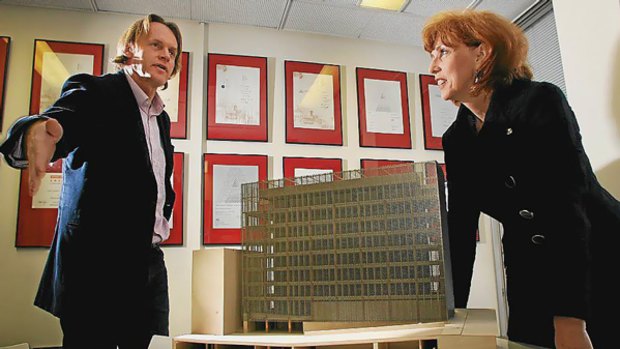By Eli Greenblat
JUST as our skin reacts with the environment around us communicating moods, regulating heat and storing energy - a building planned for RMIT University will use a shimmering jacket of glass cells to join the elements with insensate bricks and mortar.
Architect and RMIT alumnus Sean Godsell unveiled his plan for the Design Hub to BusinessDay yesterday, an innovative, landmark building for the city that has a "second skin'' enveloping an eight-level tower.

Architect Sean Godsell and RMIT vice-chancellor Margaret Gardner with the model.Credit: Justin McManus
The building will be on the corner of Swanston and Victoria streets, at the former CUB site. Mr Godsell has incorporated 16,000 glass-capped cylinders to mesh together a technologyheavy hide that adapts according to movement of the sun, rain and clouds.
"It's the analogy of human skin," Mr Godsell said. "In the way that skin protects and generates energy through vitamin D, keeps us cool when it's hot through sweating - all that skin does to preserve life we are trying to get to work in a building.
"So the second skin will preserve the environment internally, it makes for better working and better learning and that kind of thinking is right in the midst of where environmental designers are going."
Students and staff inside the building - which will include fashion and textile designers, industrial designers and landscape architects - as well as passers-by out on the street, will be treated to a stunning light show.
"It will be very prominent in the street, almost as a light sculpture," Mr Godsell said.
"So it's got a number of lives as a facade and what is an apparently simple form is actually quite animated both day and night."
Mr Godsell, a multi-awardwinning architect, is constantly pushing the boundaries of design, giving builders a challenge whenever they transform his sketches into steel and glass.
The structure of the facade allows it to be back-lit and rearprojected so the entire building has the potential to become a digital billboard. When it rains, the sandblasted surface will change from translucent to transparent, creating new textures.
The glass cylinders running east to west across the building will rotate vertically to follow the journey of the sun during the day and will be commanded by a building automation system to help shade and power the building.
At the northern and southern sides of the building the cylinders will move horizontally. Photovoltaic collectors built into the cells will harness solar power, sending energy back into the grid.
"So, on a sunny winter's day, the skin, through the building's computer system, can open right up and let the sun in, and by doing that you reduce the need for heating, and therefore heating costs, so it's a system designed to reduce energy consumption, as well as provide amenity for people working in the building."
It's something RMIT vicechancellor and president Margaret Gardner is proud to show off. The building is probably the most exciting aspect of the university's $500 million investment in RMIT's new CBD quarter.
A design institute will encourage students to develop new technologies and form relationships with industry.
The $56 million Design Hub building will have 11,000 square metres of space, and bring together postgraduate research across many disciplines to the tower, two basement levels and a sunken forecourt.
It is estimated that Sean Godsell Architects will earn a fee of about $7 million.
"The Design Hub will be a centre for collaboration - a place to develop world-class concepts and initiatives that will raise the city's and Victoria's international profile," Professor Gardner said.
Importantly, Mr Godsell's vision will not be frozen in time, as the skin has been designed to be upgraded to accommodate new solar technologies as they emerge.
"We are not limiting the life of the building," he said. "There is around the world a topical and critical discussion - and that is the discussion of environment and environmental design."
It is conceivable that as solar technology is advanced the skin will be able to supply power for the entire structure.
Mr Godsell has also fashioned an internal structure for the building that encourages students and teachers everywhere, from furniture design to aeronautical engineering, to meet and exchange ideas. It's a concept he hit on after extensive dialogue with RMIT.
"Everyone to a person said, `we just want a big old warehouse, get in there and work', and so critical ideas in our design is no columns, a giant space and an annex space."
Long rooms on each level allow for exhibition space and a home for specialist machinery winched from the basement.
"We feed people out of the lifts at one end and encourage them to filter through this space and encounter and 'bump-in'.
"The `bump-in' idea is that idea of cross-pollination, so you might have aeronautical engineers and fashion designers and the two apparently disparate functions meet . . . and ideas are exchanged."
But the new landmark won't just be for RMIT students; large open-plan spaces and a design archive will invite outsiders to see and touch the craftsmanship being generated within the university.
Pending planning approvals, RMIT hopes to break ground on the CUB site this year and have the Design Hub completed by 2011.
The bulk of former CUB brewery space will be developed by Grocon, with a planned mixed-use development incorporating commercial, retail and residential components.